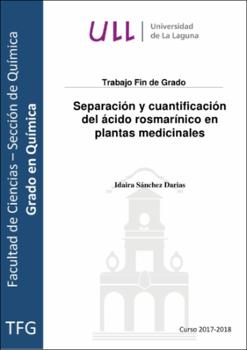Separación y cuantificación del ácido rosmarínico en plantas medicinales
Autor
Sánchez Darias, IdairaFecha
2018Resumen
El ácido rosmarínico es un ácido polifenólico bioactivo natural presente en
numerosas especies vegetales, destacando, por su alto contenido, en plantas como la
melisa (Melissa officinalis) y el romero (Rosmarinus officinalis). De igual forma,
también se encuentra en cantidades significativas en la salvia (Salvia officinalis), la
menta (Mentha piperita) y el orégano (Origanum vulgare), fundamentalmente.
Las plantas mencionadas se utilizan como condimento alimentario o se ingieren
en infusiones por la actividad antioxidante de este compuesto. Asimismo, debido a su
actividad antiinflamatoria, antibacteriana, antiviral y antimutagénica, el ácido
rosmarínico suscita especial interés en la industria farmacológica y cosmética.
En este trabajo se estudia y se adecua el procedimiento para extraer y cuantificar
el ácido rosmarínico por lixiviación, seguido de una extracción en fase sólida, y
separado y cuantificado mediante cromatografía de líquidos de alta eficacia con
detección por absorción molecular. Además, se demuestra la aplicabilidad de la
metodología propuesta en muestras de plantas medicinales. Rosmarinic acid is a natural bioactive polyphenolic acid present in numerous
plant species, specially in plants such us lemon balm (Melissa officinalis) and rosemary
(Rosmarinus officinalis) due to its high content. Likewise, it is also found in significant
amount in sage, (Sage officinalis), mint (Mentha piperita) and the oregano (Origanum
vulgare), mainly.
The plants mentioned above are used as a food-flavoring agent or are consumed
in infusions because of the antioxidant activity of this compound. Also, due to its antiinflammatory, antibacterial, antiviral and antimutagic activity, rosmarinic acid is of
interest to the pharmaceutical and cosmetic industry.
In this paper, the procedure for extracting and quantifying rosmarinic acid is
studied and adapted. Rosmarinic acid is extracted by leaching followed by solid phase
extraction and separated and quantified by high efficiency liquid chromatography with
molecular absorption detection. In addition, the applicability of the methodology
proposed to samples of medicinal plants is demonstrated.





